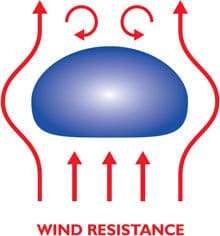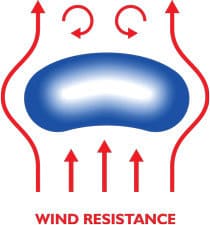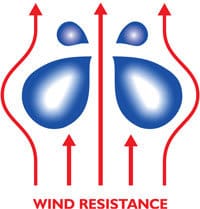Defining The Real Shape Of A Raindrop And How It Deforms

Many readers "know for a fact" that a raindrop is shaped like a teardrop. But this is actually a common misconception. The real shape of a raindrop is very different and may even vary in many cases.
A raindrop is primarily round or spherical when small microdroplets form suspended in the air during condensation. They collide and merge to form bigger waterdrops. This process continues until the droplet becomes too heavy to stay airborne and only changes shape as it starts to fall to the ground.
The vast majority of the global population is convinced all raindrops are teardrop-shaped since this is the universal shape used across all industries to represent water. Whether you find it on a beauty product or a simple weather forecast, the teardrop shape is used.
In truth, a real raindrop falling through the sky looks very different from a teardrop shape. Raindrops also do not retain their exact original form from the moment they form to the point where they start growing in size as they fall towards the ground.
And this will be the focus of this article. We will look at how a raindrop is shaped and how it changes shape as it starts falling to the ground after growing too big to be held in the air.
Before we start examining the real shape of a raindrop in the air, we first need to understand the reason for our association with a teardrop shape came.
Where Does the Teardrop Shape Come From?
The answer is straightforward. A raindrop falls too quickly and is too small for the naked eye to make a precise observation.

We have to rely on the waterdrops hanging from a faucet or tree leaf. Or observe the drops of water running down your face or a window.
In the former scenario, the skin of the waterdrop holds onto the object from which it is hanging. It creates a thin tail. The gravity causes the bulk of the water to accumulate in the lower "belly" of the drop.
In the latter scenario, the friction causes the tail to hold on to the surface of an object. The bulk of the water gets concentrated at the bottom of the drop.
In both cases, the form of the waterdrop is tear-shaped. It is also the reason we associate the shape of a raindrop with the form of a teardrop.
What Is The Real Shape Of A Teardrop?
Although a raindrop takes on multiple shapes as if it falls through the air and accumulates additional water droplets, two forms can be associated with a raindrop:
- Spherical Shape
- Oval ("Hamburger Bun Shaped") Shape
1) Spherical Shape

When humid air in the atmosphere cools down sufficiently for condensation to take place, small water droplets form around dust, pollen, and smoke particles. These water droplets are spherical (round) in shapes, mainly due to the surface tension of the skin of the droplet.
At his point, they are still extremely small, around 1 mm (0.04 inches), and trillions of these droplets are floating around in the air.
2) Oval (Hamburger Bun Shaped) Shape

As these small water droplets come in contact with each other, they merge, and the resulting raindrop grows larger. This process continues until it becomes too large to be held in the air and starts falling to the ground.
As it falls and picks up speed, the raindrop encounters wind resistance from the bottom, which flattens the underside of its surface, deforming the spherical shape.
As a result, the raindrop deforms into a distorted oval shape, much like the upper half of a hamburger bun. It is also the typical shape most experts associate with a falling raindrop.
The Ongoing Deformation And Development Of A Raindrop As It Continues To Fall To The Ground
Continual Deformation And Development

Although the forms mentioned in the previous section are the two primary shapes attributed to a raindrop, it keeps on deforming as it falls towards the ground. It keeps growing in size as it merges with more droplets and speeds up as a result.
As the bigger raindrop accelerates to the ground, it encounters even stronger wind resistance causing it to deform even further. Very soon, the shape changes to one resembling a jellybean, with the heavy outer edges pointing down.
Final Deformation And Breakup Of A Raindrop

If the raindrop continues to fall beyond this point, the wind resistance, combined with the increasing weight of the waterdrop as it gathers new smaller droplets, causes the structure to become unstable.
Eventually, this leads to the raindrop breaking apart into smaller pieces. Depending on how high up in the atmosphere it takes place, the drops that were broken up hit the ground as smaller raindrops or grow and develop in the same manner as the original raindrop.
As is clearly obvious, a raindrop may have two primary shapes. But depending on which part of its deformation cycle it is on or where it is in its path through to the ground, you can also find it in a variety of other different forms.
Conclusion
As this post illustrated, a raindrop takes on many forms after it is created and starts falling towards the ground. One shape that it is NOT, however, is that of a teardrop. (I discussed this misconception in detail at the start of the article.)
Although primarily spherical or "hamburger bun-shaped" in form, the raindrop can deform even further. If it is allowed to keep falling to the ground, grow in size, and accelerate.
(Due to the increasing wind resistance and the larger size due to the accumulation of more droplets, the raindrop may take on a peanut-shaped form or even become entirely distorted and break apart into smaller waterdrops.)
This post explained and showed what the real shape of a raindrop is and also illustrated how it changes shape and deforms as it travels to the ground.
Never miss out again when another interesting and helpful article is released and stay updated, while also receiving helpful tips & information by simply clicking on this link .
Until next time, keep your eye on the weather!

